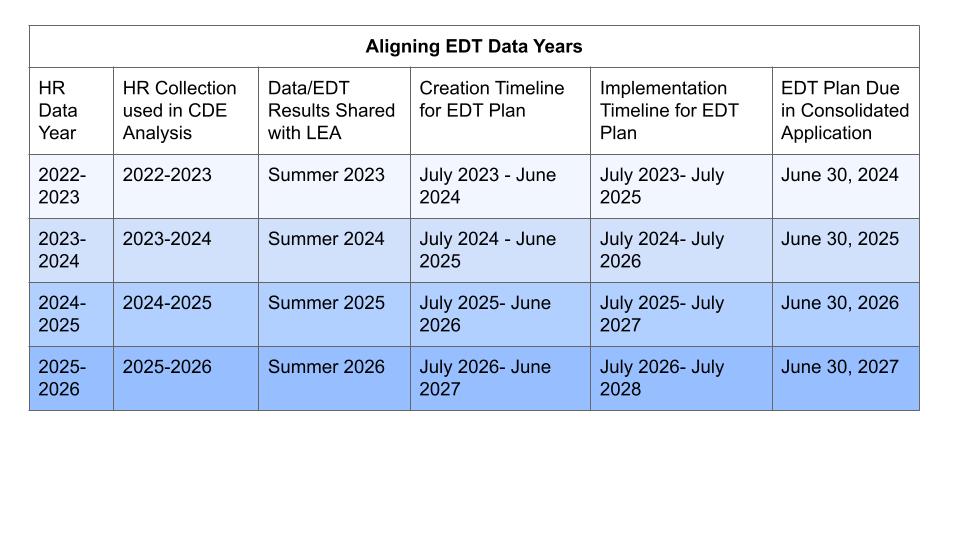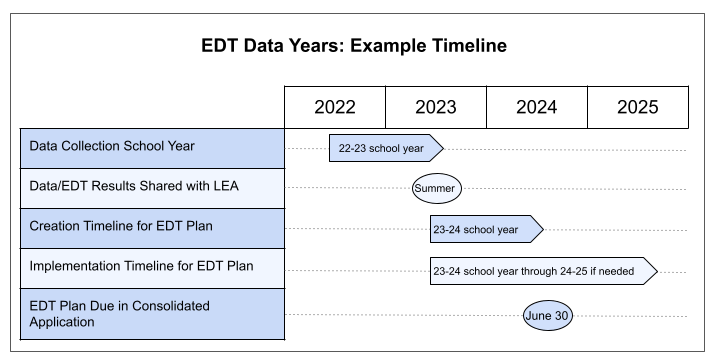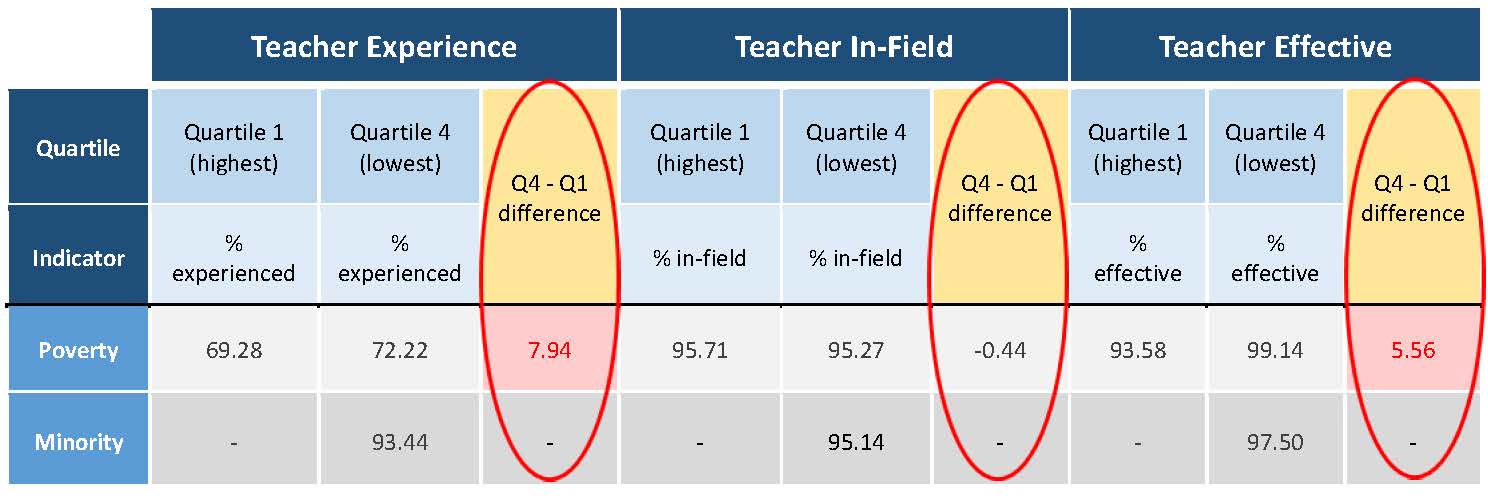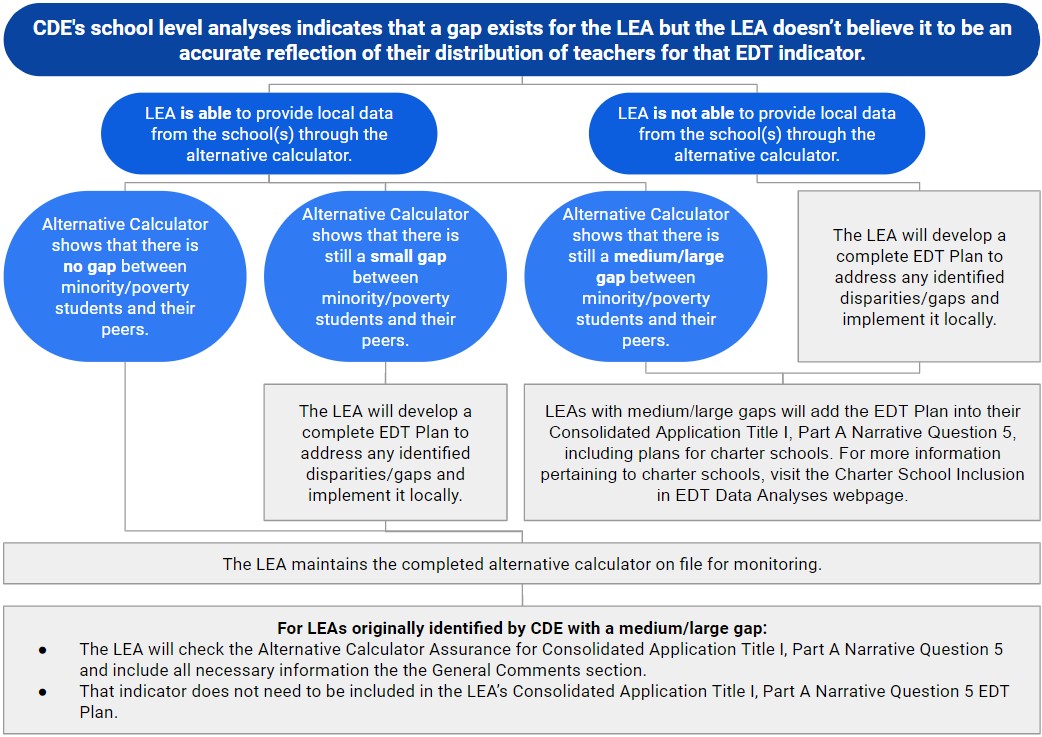You are here
Equitable Distribution of Teachers (EDT)
Overview
Equitable Distribution of Teachers: ESSA Requirements
The Elementary and Secondary Education Act (ESEA), reauthorized as the Every Student Succeeds Act (ESSA), requires state education agencies (SEAs) to evaluate annually whether low-income and minority students are taught disproportionately by ineffective, out-of-field, or inexperienced teachers compared to their higher-income, non-minority peers. CDE annually conducts the analyses on behalf of districts using Data Pipeline submissions. While the intent of EDT is to ensure equitable distribution of teachers at the student level, CDE only has the ability to conduct the analyses at the school level. Because of this limitation, LEAs have the option to use student/teacher level data to demonstrate compliance with EDT via an alternative calculator (see details below).
ESSA also requires local education agencies (LEAs) accepting Title I-A funds to submit plans to address any such disparities. LEAs with any gaps/disparities must develop a plan for addressing the inequitable distribution of their teachers. LEAs with medium or large gaps must develop a plan to address the disparities and submit that plan to CDE through the Consolidated Application. LEAs with small gaps do not need to submit their plan to CDE but should maintain the plan locally for monitoring purposes.
This guidance explains how the Colorado Department of Education (CDE) compiles and evaluates Equitable Distribution of Teachers (EDT) data and provides guidance to support LEAs to meet statutory requirements. This website also highlights strategies and funding opportunities LEAs may use to address EDT gaps.
Resources
The following resources are available to assist LEAs as they develop, implement, and evaluate the effectiveness of their plans for improving equitable access to excellent teachers.
- Self-Assessment for Healthy Human Capital
- Self-Assessment for Healthy Human Capital: Instructions on Use
- Documenting Teacher Status on EDT Indicators
- EDT Alternative Calculator
- EDT Updates 2019 (PDF)
- In-Field Crosswalk: CO License/Endorsements and Subjects
- Explanation of EDT Analysis (PDF)
- About EDT Gap Sizes (PPT)
- EDT Planning Guidance for Districts (PDF)
- EDT Strategy Guides
- EDT Gap Sizes Webinar
- Engaging Stakeholders Presentation Template (PPT)
- Meeting ESSA EDT Requirements (PDF)
- Charter School Inclusion in EDT Data Analyses
- ESSA State Plan – See Section 5.3 Educator Equity (PDF)
- Moving Toward Equity: Equitable Access Toolkit
- Colorado’s Equity Plan and Resources for Districts
- Additional Title II, Part A Resources & Tools
- 2024-25 Equitable Distribution of Teachers: District Level Data
- 2023-24 Equitable Distribution of Teachers: District Level Data
- 2022-23 Equitable Distribution of Teachers: District Level Data
- 2021-22 Equitable Distribution of Teachers: District Level Data
- 2020-21 Equitable Distribution of Teachers: District Level Data
- 2019-20 Equitable Distribution of Teachers: District Level Data
- 2018-19 Equitable Distribution of Teachers: District Level Data
- 2017-18 Equitable Distribution of Teachers: District Level Data
EDT Analysis and Reporting
CDE’s Federal Programs Unit annually conducts two EDT analyses. The first looks at distribution of teachers by student poverty rates; the second by minority students enrolled. Calculations are based on data LEAs submit through the Human Resources and December Count collections. Only full-time equivalent (FTE) data for teachers of core courses are included in EDT analyses.
In prior years, CDE had exempted districts with fewer than 1,000 students from EDT analyses. However, based on recent U.S. Department of Education’s (ED) guidance, enrollment of less than 1,000 students does not automatically exempt districts from EDT analyses. LEAs will continue to be exempt if they meet one or more of the following criteria:
-
LEAs with only one school per grade span, or
-
LEAs that declined or did not receive a Title I, Part A allocation.
CDE compares data of the district’s first quartile (highest poverty or minority) schools to its fourth quartile (lowest poverty or minority) schools to identify any gaps in percentage of effective, in-field, and experienced core-course FTE (see definitions in Table 1 below). If a district has schools in the highest poverty/minority quartile, but not in the corresponding lowest, the highest quartile percentages are compared to the State’s lowest quartile percentages. Analyses are conducted separately for each indicator of teacher quality (effective, in-field, and experienced) for poverty and minority quartiles. This results in six possible data points for each district (see sample data in Table 2 below). Each LEA is provided EDT results at the district and school level to address any identified disparities. When an inequitable distribution is identified, a percentage point gap is reported and highlighted in red.
Colorado’s ESSA State Plan defines ineffective, out-of-field, and inexperienced as follows:
| Indicator | Definition |
|---|---|
| Ineffective |
An ineffective educator has received an annual evaluation based on Colorado’s Educator Quality Standards that results in a rating of Ineffective or Partially Effective. |
| Out-of-Field |
A teacher will be determined to be out-of-field if they do not hold at least one of the following in the subject area in which they have been assigned to teach: |
| Inexperienced |
An inexperienced teacher is defined as a teacher who has 0-2 years of experience teaching in a K-12 educational setting. |
CDE includes only K-12 teachers with Job Classification codes 201 (General Ed.), 202 (Special Ed.), or 206 (Title I), and assigned the following “core course” codes:
| Code | Name |
|
0010 |
General Elementary Education |
| 0015 | General 7th/8th Grade |
| 0070 | Co Alt Exclusively |
| 0200-0299 | Art |
| 0500-0599 | English Language Arts |
| 0600-0699 | Foreign Languages |
| 1100-1199 | Mathematics |
| 1200-1299 | Music |
| 1300-1399 | Natural/Physical/General Science |
| 1500-1599 | Social Sciences |
| 1700-1799 | Special Education |
LEAs may be identified with disparities between the percent of teachers in-field, effective, or experienced teachers in highest poverty/minority schools compared to lowest poverty/minority schools. In such cases, CDE encourages LEAs developing plans to consider leading human capital system factors that influence teacher qualifications: e.g., hiring practices and protocols, recruitment efforts, preparation and licensing entry costs for incoming teachers, and ongoing professional learning. CDE encourages LEAs to prioritize Title II, Part A funding to address educator equity gaps.
Table 2. Sample District EDT Results
Note on this table: Where results are provided under “Q4-Q1 difference” column, and highlighted in red, an EDT gap was identified. Where no number is provided, e.g., “ – “, the LEA had no schools that fell into that quartile. As indicated above, if the LEA has schools in the highest poverty or minority quartile (Q1), but no schools in the lowest poverty or minority quartile (Q4), the LEA Q1 schools are compared to the state percentage for Q4. If an LEA has no schools in Q1 for poverty or minority, that LEA does not receive an EDT result – this situation is demonstrated in the table for “Minority”.
Alternative Calculators for EDT Data Analyses
Because CDE’s analyses are at the school level, LEAs with identified gaps have the option to complete an alternative calculator if local student/teacher level data demonstrates that students of poverty or minority students are taught proportionately by effective, in-field, and experienced teachers.
If the LEA chooses to use local data to demonstrate compliance with EDT requirements, they will need to:
-
Complete the CDE-provided alternative EDT calculator.
-
Maintain the completed alternative calculator and supporting data/documentation on file for monitoring purposes.
-
LEAs with medium or large gaps must also check the appropriate assurance for EDT in the LEA’s Consolidated Application Title I, Part A Narrative Question 5 stating a local student/teacher level data alternative calculator was run which demonstrates that medium/large gaps do not exist. Specify which EDT indicator(s) the alternative calculator demonstrates EDT compliance and for which years.
Note: If after using an alternative EDT calculator the LEA’s local student/teacher level data does not demonstrate compliance with EDT requirements, the LEA is still required to develop a plan to address the gap. LEAs with medium or large gaps, must submit the plan to CDE via the Consolidated Application.
EDT Trainings
EDT Training Series, Session #1: Using Data to Inform Comparability and EDT
This training will discuss the HR data reported by local education agencies (LEAs) to CDE, and how that data is used to inform calculations for Title I, Part A Comparability and Equitable Distribution of Teacher (EDT) analyses. Training will include TIPS on how to ensure these analyses contain actionable data for LEAs.
November 18, 2021
EDT Training Series, Session #2: Interpreting EDT Data Workshop
This training will guide LEAs through reading and then interpreting their annual EDT data from CDE. LEAs will then draw actionable conclusions about how equitably minority students and students of poverty are being served in their schools.
January 25, 2022
EDT Training Series, Session #3: Implementing Changes Using EDT Data Workshop
This training will provide LEAs with a range of strategies that can be implemented to positively impact an LEA’s equitable distribution of teachers.
March 20, 2022
EDT Training Series, Session #4: Building an EDT Plan Workshop
This training will help LEAs build an EDT plan that addresses gaps and adequately answers the EDT question of the Consolidated Application.
May 31, 2022
Frequently Asked Questions
Are districts required to submit any data to CDE for these analyses?
CDE’s Federal Programs Unit uses data captured through the Human Resources and October Count collections. No additional data are required.
How are the EDT analyses calculated, specifically?
CDE has posted an explanation of the EDT analysis methodology on the CDE Federal Programs website.
When are EDT analyses conducted and results disseminated?
All necessary data become available after April of each year. Allowing time for analyses and validation, results typically will be available by mid-May.
How are data made available?
CDE publicly reports LEA-level results and shares school-level data with LEAs through Syncplicity. This process protects any personally identifiable information (PII) that could be extrapolated from school-level data. If an LEA staff member needs access, please email your Regional Contact requesting access to your LEA's EDT data files and include the year(s) requested.
Are districts required to conduct their own EDT analysis?
Districts are not required to perform local EDT analyses. CDE will disseminate EDT results for districts that have more than one school per grade-span (elementary, middle, high) or more than 1,000 students enrolled. Smaller LEAs can request EDT results to inform their comprehensive needs assessment and help them reflect on how human capital factors may contribute to student performance challenges.
Are districts recommended to conduct their own analyses?
Because CDE completes EDT analyses towards the end of a given school year (e.g., EDT results for SY2018-19 are released around May 2019), LEAs may want to conduct their own analyses earlier to allow for current-school year planning and action steps.
How do I engage local stakeholders to address EDT results?
Districts identified with educator equity gaps can empower district leadership, school leaders, teachers, parents and families, and community stakeholders with EDT information to inform planning efforts. Stakeholders should be informed that EDT analyses are required under ESSA to ensure equitable student access to effective, in-field, and experienced educators. To protect PII, districts are encouraged to apply data protection practices. CDE recommends sharing:
- Percentages, not numbers. For example, “4% of FTE in high poverty schools are out-of-field,” rather than “6 FTE in high poverty schools are out-of-field.”
- Data in ranges. For example, “3%-6% of FTE teachers in high poverty schools are out-of-field.”
A PowerPoint template for LEAs to use when engaging stakeholders on EDT is available on the Federal Programs website.
When informed of educator equity gaps, stakeholders are better positioned to provide input on prioritizing challenges and developing solutions to fit local context. Districts can use EDT results to facilitate conversations with stakeholders about what gaps are occurring (educator effectiveness, in-field status, or experience), in which schools (highest poverty, minority, or both), and potential causes. Districts should utilize Teaching and Learning Conditions in Colorado (TLCC) survey responses to understand educators’ perceptions of working conditions, leadership, and where applicable, reasons for leaving schools.
Does any identified disproportionality require a plan?
Yes. According to ESSA, any identified disproportionality constitutes grounds for developing a plan to address inequitable student access to effective, in-field, and experienced teachers and excellent school leaders.
How do I know if an EDT gap is significant, relative to gaps in other Colorado districts?
CDE is developing a process to make EDT gap size more actionable and afford LEAs more flexibility.
Where do I submit my educator equity plan?
Currently, this plan is captured in the Consolidated Application for Federal funds (Title I, Question #4). Consolidated applications are due by June 30th each year. If the June 30th deadline cannot be met, gaps must be addressed within the subsequent school year. CDE is gathering stakeholder input regarding the most appropriate way to collect plans.
Are districts required to reassign teachers to different classrooms or schools to address EDT findings?
Districts with educator equity gaps may elect to make staffing changes to address disparities. However, reassigning teachers is not a requirement under ESSA, and may not address the root causes of this human capital issue. LEAs are encouraged to approach EDT issues collaboratively with stakeholders to develop plans that address compensation systems, hiring practices, educator supports, and working conditions. Plans may include a variety of strategies and supports.
What should be considered when developing a plan to address EDT results?
ESSA requires that districts develop and submit a plan to address any identified disparities in student access to experienced, in-field, and effective educators. CDE encourages districts with identified gaps to consider leading factors that influence teacher recruitment and retention when developing a plan to increase equitable access to educators:
- Salaries and other forms of compensation.
- Preparation and costs to entry.
- Hiring and personnel management.
- Induction for new teachers.
- Working conditions: Supports for all teachers.
(For more information on leading factors, research, and example district practices, please view the printable version of this resource and the table starting on page 4)
How can ESEA funds be leveraged to address gaps identified through EDT analyses?
In addition to using other ESEA program funds and state grants, LEAs can leverage Title II-A funds to address EDT gaps. As explicitly stated in the preamble to ESEA Title II, “The purpose of this title is to provide …subgrants to local educational agencies to…provide low-income and minority students greater access to effective teachers, principals, and other school leaders.” Specifically, Title II prioritizes funding for Comprehensive or Targeted Support schools, as well as those with the highest poverty rates.
When developing the application for use of Title II funds, LEAs are required to meaningfully consult with teachers, principals, other school leaders, paraprofessionals, specialized instructional support personnel, parents, community partners, and other organizations or partners.In addition, ESSA requires LEAs evaluate comprehensive programs supported through Title II funding.
Allowable uses of Title II funds include, but are not limited to:
- Implementing differential and incentive pay for teachers in high-need schools and subject areas, and specialty areas (e.g., serving ELs and SWDs), which may include performance-based compensation.
- Developing pathways for educator advancement and professional growth, with an emphasis on leadership opportunities, which may include hybrid teacher/leader and leadership positions, multiple career paths, pay differentiation and incentives for effective educators to receive additional certifications in high-need areas.
- Creating educator induction or mentoring programs to improve classroom instruction and student learning and achievement, and increase the retention of new and effective educators.
- Developing and providing training for school leaders, coaches, mentors, and evaluators on accurately differentiating performance, providing useful feedback, and using evaluation results to inform decision-making about professional development, improvement strategies, and personnel decisions.
- Developing feedback mechanisms to improve working conditions in schools, including periodic and public reporting of educator support and working conditions feedback.
What State resources are available to help attract and retain experienced, effective, and in-field teachers?
Districts experiencing teacher shortages may also leverage competitive grants developed by the Colorado State Legislature to attract, retain, and grow effective teachers. Small districts, in particular, may benefit from these grant opportunities.
For Additional Information Contact
For General EDT Questions Contact:
Rachel Echsner
ESEA Title I & II Specialist
303-681-6486 (c)
echsner_r@cde.state.co.us
For Questions Regarding EDT Data Calculations Contact:
Tina Negley
DARE Coordinator
720-766-2793 (c)
negley_t@cde.state.co.us






Connect With Us





